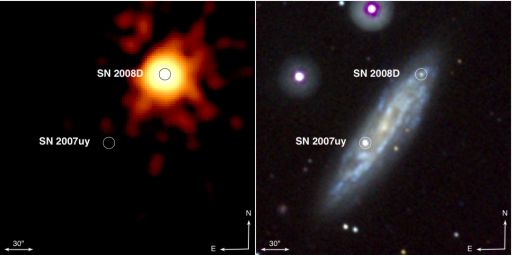Astronomers Catch First Stirrings of a Supernova
| May 23, 2008 |
| It took decades of observations, the latest technology, and a good deal of plain old fashioned luck, but it was finally done: In January of this year astronomers have finally caught a supernova in the very act of exploding. Over the years scientists have observed thousands of these spectacular stellar explosions but they always arrived on the scene some time after the fireworks were uderway. This is the first time the early stirrings of a supernova have been observed, and the implications for ther study are enormous: This will be "the Rosetta stone of supernova studies for years to come" predicted Alicia Soderberg, a a Carnegie-Princeton Fellow at Princeton University and leader of the team that detected the event. A typical supernova occurs when the core of a giant star, at least 8 times as massive as our Sun, completes its cycle of converting hydrogen into heavier elements and and runs out of nuclear fuel in its core. Within milliseconds, the star collapses under its own gravity. compresses, and then rebounds in an explosion that plows through the star's gaseous outer layers and sends heavy elements forged in the star's core into interstellar space. Since this is one of the chief mechanisms by which heavy elements are disseminated, supernovae play a crucial role in the evolution of the universe. When seen from Earth, they appear as a new and brilliant star in a place where no star, or a very faint one, were observed before. For nearly four decades astronomers have believed that the beginning of a supernova explosion will be marked by a bright X-ray emission lasting a few minutes. But until these recent observations, astronomers have never observed this signal. Instead, they have observed supernovae brightening days or weeks later, when the expanding shell of debris is energized by the decay of radioactive elements forged in the explosion. "Seeing the shock break-out in X-rays can give a direct view of the exploding star in the last minutes of its life and also provide a signpost to which astronomers can quickly point their telescopes to watch the explosion unfold," says Edo Berger, a Carnegie-Princeton Fellow at Princeton University. Soderberg's discovery of the first shock breakout can be attributed to luck and Swift's unique design. On January 9, 2008, Soderberg and Berger were using Swift to observe a supernova known as SN 2007uy in the spiral galaxy NGC 2770, located 90 million light-years from Earth in the constellation Lynx. At 9:33 a.m. EST they spotted an extremely bright 5-minute X-ray outburst in NGC 2770. They quickly recognized that the X-rays were coming from another location in the same galaxy. In a paper appearing in the May 22 Nature, Soderberg and 38 colleagues show that the energy and pattern of the X-ray outburst is consistent with a shock wave bursting through the surface of the progenitor star. This marks the birth of the supernova now known as SN 2008D. |
 |
| supernova SN2007uy in galaxy NGC 2770 |
| Supernova SN2008D Alicia Soderberg and her colleagues were monitoring supernova SN2007uy in galaxy NGC 2770, 90 million light years away, when a new supernova appeared in the same galaxy. Designated SN2008d, it is the first supernova whose birth was observed and recorded. The righthand image shows the two supernovae in visible light, the lefthand image in the X-ray range. Credit: NASA/Swift Science Team/Stefan Immler |
| Although astronomers were lucky that Swift was observing NGC 2770 just at the moment when SN 2008D's shock wave was blowing up the star, Swift is well equipped to study such an event because of its multiple instruments observing in gamma rays, X-rays, and ultraviolet light. "It was a gift of nature for Swift to be observing that patch of sky when the supernova exploded. But thanks to Swift's flexibility, we have been able to trace its evolution in detail every day since," says Swift lead scientist Neil Gehrels of NASA's Goddard Space Flight Center in Greenbelt, Md. Due to the significance of the X-ray outburst, Soderberg immediately mounted an international observing campaign to study SN 2008D. Observations were made with major telescopes such as the Hubble Space Telescope, the Chandra X-ray Observatory, the Very Large Array in New Mexico, the Gemini North telescope in Hawaii, the Keck I telescope in Hawaii, the 200-inch and 60-inch telescopes at the Palomar Observatory in California, and the 3.5-meter telescope at the Apache Point Observatory in New Mexico. The combined observations helped Soderberg and her colleagues pin down the energy of the initial X-ray outburst, which will help theorists better understand supernovae. The observations also show that SN 2008D is an ordinary Type Ibc supernova, which occurs when a massive, compact star explodes. Significantly, radio and X-ray observations found no evidence that a jet played a role in the explosion, ruling out a rare type of stellar explosion known as a gamma-ray burst. "This was a typical supernova," says Swift team member Stefan Immler of NASA Goddard. "The significance is not the explosion itself, but the fact that we were able to see the star blow up in real time, which gives us unprecedented insight into the explosion process." |
Article reprinted on this website courtesy of http://redrover.planetary.org/ |
